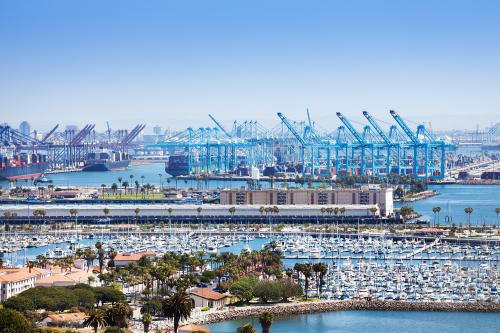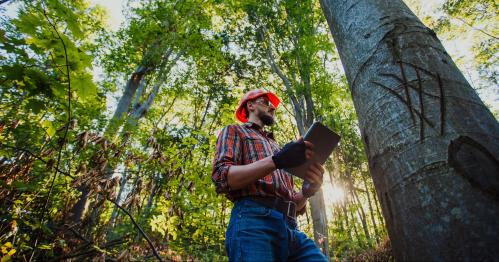Together, the Infrastructure Investment and Jobs Act (IIJA) and Inflation Reduction Act (IRA) invest over $1 trillion to address climate needs and improve our transportation, water, energy, and broadband systems. Federal funds are already flowing to states and localities, supporting thousands of new projects across the country. These laws have tremendous potential to create jobs: manufacturing batteries and electric vehicles (and building the associated facilities to do so), installing and maintaining electric vehicle charging stations, deploying broadband, maintaining clean drinking water systems, weatherizing and updating buildings to improve their energy efficiency, and more.
Workforce leaders can leverage their existing resources, partnerships, and expertise to help infrastructure entities take a more forward-looking and strategic approach to recruiting, training, and retaining workers.
But there’s a problem. The laws are not strategic nor proactive about ensuring that enough workers will be available and prepared to carry out the projects the legislation envisions. Without sufficient workers, projects will experience cost overruns, quality control problems, and delays. Yet workforce boards, community colleges, apprenticeship programs, and other education and training programs are in a prime position to head off these problems by offering support to the state and local leaders receiving IIJA and IRA funds.
This piece aims to help education and training leaders navigate these laws and articulate their value within the current landscape of federal investment. Workforce leaders can leverage their existing resources, partnerships, and expertise to help infrastructure entities take a more forward-looking and strategic approach to recruiting, training, and retaining workers.
The IIJA and IRA focus on capital projects and physical operations, not on developing workers
Broadly speaking, the IIJA and IRA recognize the need for workforce development. But they are vague about what it will take to recruit and prepare talent. Notably, the laws direct no explicit funds to the Department of Labor, nor do they invest in strengthening the public workforce development system, such as state and local workforce development boards, state and federal apprenticeship offices, career and technical education programs, or community colleges.
Workforce actors are thus in a challenging position. They see labor market trends better than most, but don’t control any of the IIJA or IRA funds by default (although they can apply for some competitive grants). The laws mostly allow for—but do not require—workforce development activities, and there are few automatic mechanisms to bring workforce leaders together with the people prioritizing or carrying out infrastructure projects.
IIJA and IRA funds generally flow to entities such as state transportation departments or water and energy utilities. The private sector will also receive IRA funds via tax credits. These entities generally have the flexibility to use their funds for workforce development purposes, but they don’t have to (with only a few exceptions). Even if they wanted to prioritize talent development, they may not be sure how to go about it. Many (or most) have not typically had strong relationships with educational institutions or workforce boards, nor have they been highly involved in activities such as modernizing apprenticeships, creating additional work-based learning opportunities, or forging sector partnerships with community colleges and workforce boards.
To have an impact in this context, workforce leaders should draw upon their convening power and expertise to inform and shape how public and private sector actors prepare workers for infrastructure and clean energy projects. They will need to build or strengthen relationships with the entities funding or carrying out infrastructure projects, and make the case that a more strategic approach to workforce development is in their self-interest. Given demographic trends and the tight labor market, infrastructure entities cannot assume that someone else will develop the workers they need. They will need to be proactive and strategic about talent development to achieve their goals.
The laws require state and local actors to take the initiative on workforce development activities
Eligible workforce activities include general skills development, on-the-job training, apprenticeships, and career and technical education at the high school and postsecondary level. Below are highlights of the laws and how they approach workforce development.
Infrastructure Investment and Jobs Act:
- The law touches a wide variety of sectors, including transportation, broadband deployment, energy, water quality, and public works. It is heavily weighted toward transportation, but because the law is so large, other sectors also receive substantial amounts of funding.
- The law supports an estimated $864 billion in investments over five years via 400-plus programs across multiple federal agencies, including the Department of Transportation, Department of Energy, Department of Commerce, and Environmental Protection Agency.
- More than 70 programs allow or encourage workforce development activities, but only a small number require workforce activities.
- States play a critical role. Almost 80% of funds allowing workforce activities pass through formula programs that go to designated state agencies, which have high levels of discretion in what they fund and prioritize. Key state players include transportation departments and agencies addressing energy, broadband, and water.
- There are also competitive grant programs issued directly from federal agencies. A range of entities and coalitions can apply, and federal agencies can provide more specific guidance about workforce development than is often possible with formula funds.
Inflation Reduction Act:
- The Inflation Reduction Act directs close to $400 billion through nearly 140 programs to reduce carbon emissions and support clean energy. It also supports more energy-efficient housing and clean manufacturing and vehicles. It does this through a mix of grants, loan guarantees, and tax credits for companies and individuals. (The total cost may well be higher, since many of the tax credits are uncapped.) Like the IIJA, many programs allow or incentivize workforce development.
- The largest share of the law’s expenditures will go to the private sector via tax credits designed to incentivize investment in low-carbon energy sources such as wind, solar, and nuclear. The tax incentives have the most direct connection to workforce development: For many of them, credits are multiplied by five if the projects incorporate registered apprenticeships and pay prevailing wages.
Workforce organizations can help infrastructure employers act more strategically
As my colleague Joseph W. Kane has analyzed in detail, the infrastructure workforce is aging and employers are struggling to retain their current workers, let alone find more. Long-term demographic shifts will exacerbate these challenges. The U.S. under-18 population is declining, both in absolute numbers and as a share of the total population. And while the existing infrastructure workforce is predominantly white, young Americans are more racially and ethnically diverse than previous generations. People of color account for more than half of the under-18 population, which represents the nation’s future talent pool.
All too often, however, infrastructure employers (and plenty of employers in other sectors) treat recruiting, training, and hiring practices as an afterthought. But relying on just-in-time hiring and existing social and professional networks for recruitment is not a recipe for success.
Meanwhile, the bread and butter of workforce organizations is to understand labor market dynamics and strategies to connect workers to jobs. They’re embedded in the larger ecosystem of education, training, and social service organizations. They offer a wealth of knowledge and expertise that infrastructure agencies and employers need—even if they don’t know they need it.
Workforce boards, apprenticeship programs, community colleges, and other education and training providers can link employers to broader, more diverse recruitment pools and help them form partnerships with training programs that provide access to new sources of talent. They can assist with assessment and screening to improve job matches. They can work with infrastructure agencies and employers to identify which positions may be the most challenging to fill and narrow in on mission-critical occupations. They can help employers answer key questions, such as: What are the foundational sets of knowledge, skills, and abilities for mission-critical occupations? Can employers agree upon a shared set of skills for specific positions? Can specific skill sets transfer across projects?
Skilled trades positions will be in demand almost everywhere, although the particulars will vary by place. There will also be a need for project managers, IT specialists, and other administrative, financial, and managerial roles. In addition to creating new jobs, new technologies and climate priorities will lead to major changes in existing roles and tasks that will require updating the skills of existing workers and updating curricula at all levels.
Lastly, and perhaps most crucially, workforce leaders can help employers and industry groups develop into consistent partners in talent development. Education and training organizations will not be able to successfully recruit and prepare workers unless employers clearly assess and communicate their workforce needs. Moreover, employers cannot act just as consumers of workforce development efforts. They will need to contribute to curriculum development, facilitate work-based learning, and re-evaluate their HR practices. How up to date are their job descriptions? Who are they reaching in their outreach and recruitment efforts? How do they assess skills? Do they help incumbent workers grow into positions of higher responsibility? What practices improve retention?
Workforce leaders should seek to embed better recruitment, hiring, and training processes within infrastructure initiatives
Approaching workforce issues on a project-by-project basis will be valuable for the projects in question, but is unlikely to fully meet the labor market needs of a state or region, given the scale of IIJA- and IRA-supported investments. To move beyond one-off initiatives and isolated partnerships, infrastructure agencies and employers need to dramatically increase how much they share information, coordinate with each other, and ultimately align their strategies. Education and training providers can prepare workers more efficiently and effectively if they are responding to an organized employer community rather than a fragmented one.
Workforce leaders know this, of course—and many already have considerable experience organizing such approaches. Aggregating the workforce demand of employers in the same sector (or occasionally different sectors with strong talent adjacencies) is the basic principle of sector strategies and related efforts such as the U.S. Chamber of Commerce Foundation’s Talent Pipeline Management process. Less clear is how to marry this approach with the firehose of federal money coming down—none of which goes to workforce agencies.
Workforce leaders need to understand the infrastructure and clean energy landscape in which they operate
If they haven’t already, workforce leaders need to do some basic information-gathering to better understand infrastructure projects and investments that will shape workforce demand in their area. While this does involve a time commitment among busy people, it is hard to see how they will be prepared to respond to future labor market opportunities otherwise.
Some projects will be obvious based on their size and prominence, such as new electric vehicle or battery manufacturing plants. But it will take more digging to identify, for example, if state or local agencies and organizations have applied for competitive grants, whether from the Department of Transportation, Department of Energy, Department of Commerce, Environmental Protection Agency, or another federal agency. Another potential topic to investigate is what state departments of transportation and energy are doing with their formula funds. Workforce leaders should draw upon their relationships with relevant public and private sector actors to investigate. Biden administration websites of IIJA and IRA investments along with maps of public and private investments in a variety of sectors are also resources.
Questions for workforce leaders to guide their assessment of activities and investments are listed in the textbox at the end of this report. The purpose of the exercise is not to generate perfect or comprehensive information. Rather, it is to generate intelligence that helps workforce leaders roughly understand the factors shaping future labor market demand—and provide leads for them to follow given their knowledge of the politics and economics of their area.
It’s not necessary for workforce leaders to track down every competitive grant or plan, but a basic sense of the politics is critical. If governors or mayors have not made workforce a priority, workforce leaders will have less wind at their back as they determine their next steps. Similarly, the interest and capacity of infrastructure leaders in different sectors (water, energy, transportation, etc.) really matter. Some are more likely to be receptive to partnerships with workforce entities than others. And a rough idea of the types of projects the IIJA and IRA generate is also critical, so workforce leaders can assess how they are best positioned to contribute and plug in.
In the end, achieving the nation’s infrastructure and clean energy goals requires a sufficient workforce. This will require more focused and strategic approaches to talent development than infrastructure and clean energy entities are accustomed to, and they will need to develop more transparent and accessible career opportunities for job seekers and talent in communities that historically have been marginalized from those industries and jobs. Workforce leaders can provide critical assistance on this front by doubling down on what they already do: build relationships across sectors, convene actors to address shared problems, and demonstrate their value in helping infrastructure actors recruit, train, and retain the workers they need.
Key questions to help workforce leaders scan the infrastructure and clean energy landscape in their state and region
- Has the governor, mayor, or other executive branch leadership prioritized workforce development in public statements or plans? Can workforce leaders inform the executive office’s thinking on this matter?
- Who is the state infrastructure coordinator and how are they approaching the role? What is the bird’s eye view of projects and funding inflows across the state? How is the state allocating resources, monitoring progress, supporting local action, and setting priorities for investments? Is anyone gathering, synthesizing, and sharing such information?
- Who are the state and local infrastructure leaders who control or direct infrastructure and climate funds? Agencies to review include those in transportation, transit, energy, environment, drinking water, wastewater treatment, broadband, and public works. Have state or local agency heads said or done anything to support workforce development? What contractors do these agencies typically work with, and do they have relationships with workforce and apprenticeship programs?
- Are any companies aware of and planning to apply for clean energy tax credits that incentivize registered apprenticeship programs? Are chambers of commerce, business groups, or economic development agencies promoting the tax credits?
- Have any agencies or coalitions in the state or region been awarded competitive grants? Some of the largest and most high-profile awards include RAISE and INFRA from the Department of Transportation and Regional Clean Hydrogen Hubs from the Department of Energy, although there are many others.
- What are the priorities and plans laid out in various public documents? Consider the following:
- Required by the federal government
- Plans that states or regions may develop depending on their own laws and priorities
- Climate or energy plans (more information here, here, and here)—do they say anything about green jobs?
-
Table 1. IIJA programs that allow workforce development
-
Table 2. IRA programs that allow workforce development
Federal agency Type of funding Program Further information IRS Tax credit Eligible applicants for the following tax credits can increase the value of their credits by five times if they meet certain conditions: Pay prevailing wage rates and employ apprentices in registered apprenticeship programs for a certain number of hours:
• Alternative Fuel Refueling Property Credit
• Renewable Electricity Production Credit
• Clean Electricity Production Credit
• Credit for Carbon Oxide Sequestration
• Credit for Production of Clean Hydrogen
• Clean Fuel Production Credit
• Energy Credit
• Clean Electricity Investment Credit
• Qualifying Advanced Energy Project Credit
• Energy Efficient Commercial Buildings DeductionPay prevailing wage rates only (no apprenticeship requirement):
• New Energy Efficient Home Credit
• Zero-Emission Nuclear Power Production CreditIRS: Prevailing wage and apprenticeship requirements EPA Competitive grant Clean Heavy-Duty Vehicle Program Building a Clean Energy Economy (page 89) EPA Competitive grant Environmental and Climate Justice Program Building a Clean Energy Economy (page 86) DOT Competitive grant Neighborhood Access and Equity Program Building a Clean Energy Economy (page 88) USDA Competitive grant Urban and Community Forestry Program Building a Clean Energy Economy (page 157) -
Table 3. IIJA and IRA programs that require workforce development
Law Federal agency Type of grant Program IRA DOE Formula and competitive State-Based Home Energy Efficiency Contractor Training Grants IIJA DOE Competitive Career Skills Training Program IIJA DOE Competitive Energy Auditor Training Grant Program IIJA DOE Competitive Building Training and Assessment Centers IIJA DOE Competitive Industrial Assessment Centers IIJA DOE Competitive Innovative Water Infrastructure and Workforce Development Program IIJA DOT Formula Training and Education IIJA DOT Formula On-the-Job Training IIJA DOT Formula Public Transportation Technical Assistance and Workforce Development
Note: Lists of IIJA and IRA programs that allow or require workforce development activities are available for download.
The Brookings Institution is committed to quality, independence, and impact.
We are supported by a diverse array of funders. In line with our values and policies, each Brookings publication represents the sole views of its author(s).



